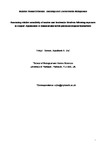Assessing relative sensitivity of marine and freshwater bivalves following exposure to copper: Application of classical and novel genotoxicological biomarkers
| dc.contributor.author | Jha, Awadhesh | |
| dc.contributor.author | Vernon, E | |
| dc.date.accessioned | 2019-04-01T14:54:23Z | |
| dc.date.issued | 2019-01-18 | |
| dc.identifier.issn | 1383-5718 | |
| dc.identifier.issn | 1879-3592 | |
| dc.identifier.uri | http://hdl.handle.net/10026.1/13594 | |
| dc.description.abstract |
© 2019 Elsevier B.V. Determination of relative sensitivity of biota following exposures to contaminants including metals is important for environmental protection. Copper (Cu), although biologically essential can be highly toxic to biota if present at higher concentrations in the natural environment. Given its ubiquitous presence within coastal and inland water bodies, we compared Cu-induced genotoxicity in two ecologically important mussel species, the freshwater Dreissena polymorpha (DP) and marine Mytilus galloprovincialis (MG), along with its tissue specific accumulation. Novel biomarker in terms of induction of gamma H2AX (γ-H2AX) foci, along with comet assay and induction of micronuclei (MN) were used to determine DNA damage response (DDR) in these two species following exposure to a range of Cu concentrations (18, 32, 56 μg L−1) for 10 days. Concentration-dependent increases in Cu concentration in gill tissue, as determined by Inductively Coupled Plasma Mass Spectrometry (ICP-MS), were paralleled by a greater degree of genotoxicity. An induction of γ-H2AX foci was present in all Cu exposure concentrations, proving this technique to be a sensitive and suitable biomarker of genotoxicity in bivalves. The multi-biomarker approach adopted here suggests firstly that in parallel with MG, which is widely used to assess the health of marine and coastal environment, DP is also suitable representative of inland water bodies, and that there is a similar mechanism of action for the induction of genotoxicity between the two species, following exposure to Cu. Secondly, for genotoxicity assessment a battery of responses could simultaneously be assessed in these two bivalve species. Finally, for adequate protection of the environment it is vital to adopt a multi-biomarker, multi-species approach to determine adverse biological effects to gain a holistic understanding of the real threat posed by contaminants to hydrosphere. | |
| dc.format.extent | 60-71 | |
| dc.format.medium | Print-Electronic | |
| dc.language | en | |
| dc.language.iso | en | |
| dc.publisher | Elsevier | |
| dc.subject | Metals | |
| dc.subject | Bivalve | |
| dc.subject | DNA damage | |
| dc.subject | gamma-H2AX | |
| dc.subject | Bioaccumulation | |
| dc.subject | Genotoxicity | |
| dc.title | Assessing relative sensitivity of marine and freshwater bivalves following exposure to copper: Application of classical and novel genotoxicological biomarkers | |
| dc.type | journal-article | |
| dc.type | Journal Article | |
| dc.type | Research Support, Non-U.S. Gov't | |
| plymouth.author-url | https://www.webofscience.com/api/gateway?GWVersion=2&SrcApp=PARTNER_APP&SrcAuth=LinksAMR&KeyUT=WOS:000474676600007&DestLinkType=FullRecord&DestApp=ALL_WOS&UsrCustomerID=11bb513d99f797142bcfeffcc58ea008 | |
| plymouth.volume | 842 | |
| plymouth.publication-status | Published | |
| plymouth.journal | Mutation Research - Genetic Toxicology and Environmental Mutagenesis | |
| dc.identifier.doi | 10.1016/j.mrgentox.2019.01.008 | |
| plymouth.organisational-group | /Plymouth | |
| plymouth.organisational-group | /Plymouth/Admin Group - REF | |
| plymouth.organisational-group | /Plymouth/Admin Group - REF/REF Admin Group - FoSE | |
| plymouth.organisational-group | /Plymouth/Faculty of Science and Engineering | |
| plymouth.organisational-group | /Plymouth/Faculty of Science and Engineering/School of Biological and Marine Sciences | |
| plymouth.organisational-group | /Plymouth/REF 2021 Researchers by UoA | |
| plymouth.organisational-group | /Plymouth/REF 2021 Researchers by UoA/UoA06 Agriculture, Veterinary and Food Science | |
| plymouth.organisational-group | /Plymouth/Research Groups | |
| plymouth.organisational-group | /Plymouth/Research Groups/Marine Institute | |
| plymouth.organisational-group | /Plymouth/Users by role | |
| plymouth.organisational-group | /Plymouth/Users by role/Academics | |
| plymouth.organisational-group | /Plymouth/Users by role/Researchers in ResearchFish submission | |
| dc.publisher.place | Netherlands | |
| dcterms.dateAccepted | 2019-01-17 | |
| dc.rights.embargodate | 2020-1-18 | |
| dc.identifier.eissn | 1879-3592 | |
| dc.rights.embargoperiod | Not known | |
| rioxxterms.funder | Natural Environment Research Council | |
| rioxxterms.identifier.project | TRansfer - Exposure - Effects (TREE): integrating the science needed to underpin radioactivity assessments for humans and wildlife | |
| rioxxterms.versionofrecord | 10.1016/j.mrgentox.2019.01.008 | |
| rioxxterms.licenseref.uri | http://www.rioxx.net/licenses/all-rights-reserved | |
| rioxxterms.licenseref.startdate | 2019-01-18 | |
| rioxxterms.type | Journal Article/Review | |
| plymouth.funder | TRansfer - Exposure - Effects (TREE): integrating the science needed to underpin radioactivity assessments for humans and wildlife::Natural Environment Research Council |


